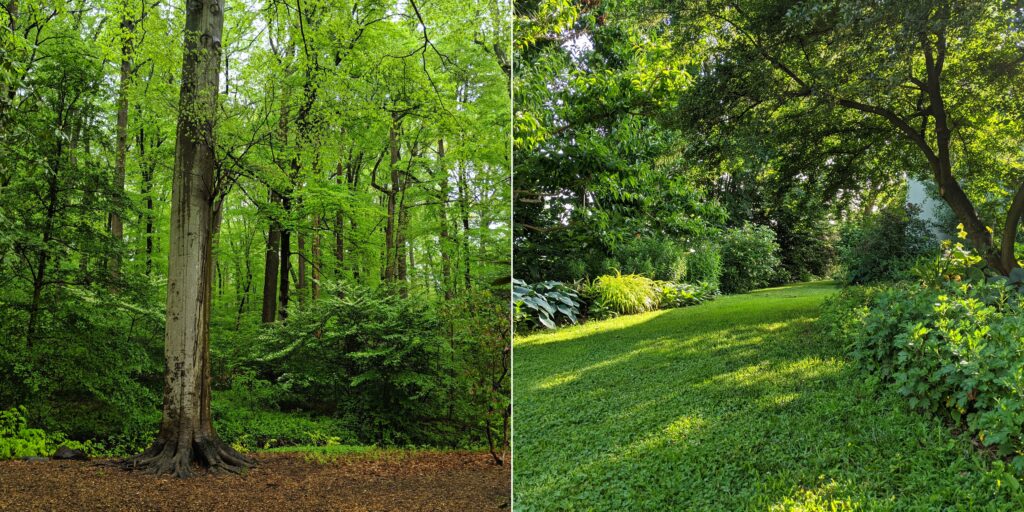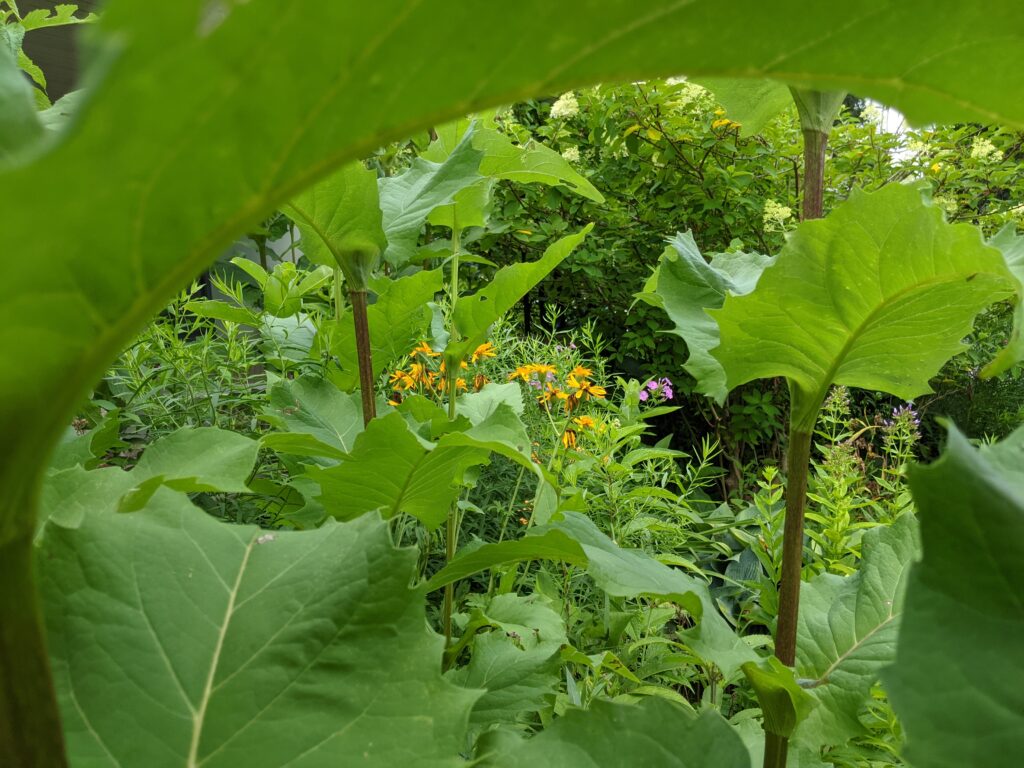To garden frugally is to work with the land, to grow resilience for yourself, for your community, and for the Earth. From The Frugal Garden, June 2022
The last two years have taught me two things: where to spend my time and where I can pull back. This certainly applies now as our dollars are asked to do more while our options are limited by gas prices, rising costs and availability or lack thereof. I am speaking about our gardens and how our oases can be edited to give us more joy and beauty without the guilty feeling of overspending, or spending our time needlessly on an avoidable chore.
Yes, I said a chore that can be avoided like weeding! After over 35 years of growing plants and creating spaces, I’ve finally learned a few lessons on how to cut down on weeding time. Here are just a few:
- Pack it tight!
Plants packed in together will not allow weeds to grow in between them. I’m notorious for planting my perennials way too close. Planting perennials closely allows for the quick cover of open ground and cutting off much needed light for those weed seeds to germinate and flourish. It is still essential to weed in the first year while the perennials establish a good root system, but after that, the plants themselves will keep the weeds in check.
Packing it tight also means you need a good source of plants and plenty of them. Get smaller plants in quart size or plugs. I have been known to dig, divide and relocate existing plants. I have also purchased very small plants or received unsellable nursery plants after the spring rush and potted them up for up-sizing, which allows me to keep an eye on them on my patio and plant them later in the fall. Planting smaller plants enables you to get into areas where tree or shrub roots may be in the way of more developed plants in bigger pots or with bigger root balls. It is okay for plants to be touching each other!
The following photos show areas in my garden and Tyler’s entrance path, showing how tightly packed perennials can help.
- Create Layers
A healthy, beautiful, natural landscape has three layers — the tree layer, the shrub layer and then the ground layer. Come out to the Native Woodland Walk and take a good look at the scene. In the Native Woodland Walk, you are greeted with sourwood (Oxydendrum arboretum), Kentucky yellow wood (Cladrastis kentukea), tulip trees (Liquidambar styraciflua) and large majestic American beeches (Fagus grandifolia). Under that layer are large rhododendrons planted by Dr. Wister, bush honeysuckle (Diervilla lonicera) — a native shrub that the pollinators love and a bower of bottlebrush buckeyes (Aesculus parviflora). These shrubs help create intimate spaces and support our ecosystem with food for our insect friends. So take a seat on the benches and see who passes by.
Finally, near the ground are perennials that meander under the shrubs. They help smother weeds and keep root areas cool. Here, ground inhabiting animals and insects can find shelter and food in these low-growing plants. Look for the yellow root (Xanthorhiza simplicissima), Goldie’s fern (Dryopteris goldiana) and hairy alum root (Heuchera villosa).
By planting in layers in your garden, you mimic how nature behaves and ensure a balanced system. Now get outside and look at your garden. Can you identify the layers? If you have a very small urban garden, the likelihood of having a big beech tree or even a birch is very slim. Treat the house as the tree layer – the shadow it creates is similar to a dense tree canopy. Do you have room for shrubs underplanted with a ground cover? Perhaps planting a witch hazel (Hammelis vernalis) will create a fragrant focal point for you and a great food source for birds. For ideas on which ground covers to use, check out this blog on the subject.
If you’re also pressed for space in the shrub layer, consider a smaller cultivar (or cultivated variety) of some of our favorite larger garden plants. For example, Oakleaf hydrangea ‘Ruby Slippers’ or ‘Pee Wee’ (Hydrangea quercifolia ‘Ruby Slippers’ and ‘Pee Wee’) are beautiful shrubs that don’t get taller than four or five feet. Buttonbush ‘Sugar Shack’ or ‘Magical Moonlight’ (Cephalanthus occidentalis ‘SMCOSS’ ‘Sugar Shack’ or ‘Magical Moonlight’) are compact varieties of the large, native buttonbush.
- Let it go to seed
Plants love to seed around if they like their environment — let them. I planted my pollinator garden next to the vegetable garden. The space was approximately 30’ x 6’. The first year I planted seedlings, I dug from my front yard: blue star (Amsonia tabernaemontana), golden anise hyssop (Agastache rugosa ‘Golden Jubilee’) and coneflower (Echinacea purpurea). I had “passed along” butterfly weed (Asclepias tuberosa), gayfeather (Liatris spicata), beard tongue (Penstemon digitalis) and rattlesnake master (Eryngium yuccifolium) because someone had too many popping up in their garden! I purchased four plants – two culinary sages (Salvia officinalis), Raydon’s Favorite aromatic aster (Symphyotrichum oblongifolium ‘Raydon’s Favorite’) and a hardy mum (Chrysanthemum ‘Hillside Sheffield Pink’). Four years later, I have at least three dozen rattlesnake masters, many more golden anise hyssops and coneflowers. If I’m not vigilant, the blue stars and beard tongues will try to spring up everywhere. By the way, I’ve been rogueing rattlesnake masters from the vegetable garden as they marched into sacred territory. Once again, I weed in April and the perennials shade out the competition the rest of the time. Aside from providing free plants, letting your plants go to seed will also support bird populations. Finches adore anise hyssop and coneflower seeds. The hardy mum that I planted as a quart-size perennial has spread to over four feet wide and is currently crowding out the competition. Even though the mum will not seed around, it is extremely easy to plant cuttings taken in June, providing pollen for late-season insects.
What’s my garden maintenance routine now? April is spent weeding cool-season weeds and cutting perennials I left from the previous year. By May, most of the ground is covered with plants emerging, and the tree layer has knitted in. I may spot a rogue pokeweed, Boston ivy, or poison ivy, all deposited by birds. They are quickly banished with weed pulling after a good rain – so much easier to weed after the rain. In the case of the poison ivy, a small shovel and gloves will keep you safe. A week of “editing” aggressive perennials is completed in May. That is when I move seedlings to new spots, to a friend’s yard or the compost pile.
I think I’ve started colonies of cup plants (Sylphium perfoliatum) all over northern Delaware, Delco and Chesco – including Tyler’s Rain Garden and Children’s Play area. Most of June is spent cutting back tall, late-blooming perennials, so they don’t flop on the shorter perennials. They quickly rebound and grow thicker. During July and August, if I’m not watering new plantings from the spring, you can find me hiding out as the temperature and humidity rises. The garden is thick and lush. September is spent “editing” more areas which means cutting back, relocating seedlings or removing plants. I also plant the potted perennials from spring so they can overwinter in the ground. I let the early November frost do its thing and let the garden sleep. The fallen leaves are raked into the beds. I do not cut back perennials unless they are falling over pathways or causing harm to other plants. This is my year of gardening with nature. The vegetable garden routine is very different. For more information on that, visit our Lucille’s Garden page. It is about understanding how plants like to grow and working with them.
For more information about frugal gardening, visit The Frugal Garden webpage!














